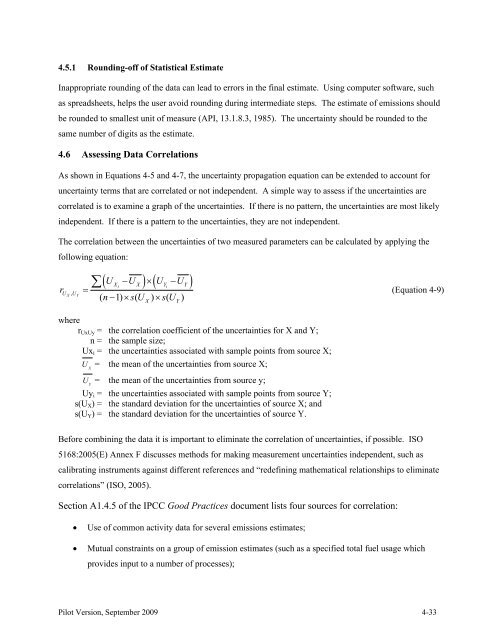addressing uncertainty in oil and natural gas industry greenhouse
addressing uncertainty in oil and natural gas industry greenhouse
addressing uncertainty in oil and natural gas industry greenhouse
You also want an ePaper? Increase the reach of your titles
YUMPU automatically turns print PDFs into web optimized ePapers that Google loves.
4.5.1 Round<strong>in</strong>g-off of Statistical Estimate<br />
Inappropriate round<strong>in</strong>g of the data can lead to errors <strong>in</strong> the f<strong>in</strong>al estimate. Us<strong>in</strong>g computer software, such<br />
as spreadsheets, helps the user avoid round<strong>in</strong>g dur<strong>in</strong>g <strong>in</strong>termediate steps. The estimate of emissions should<br />
be rounded to smallest unit of measure (API, 13.1.8.3, 1985). The <strong>uncerta<strong>in</strong>ty</strong> should be rounded to the<br />
same number of digits as the estimate.<br />
4.6 Assess<strong>in</strong>g Data Correlations<br />
As shown <strong>in</strong> Equations 4-5 <strong>and</strong> 4-7, the <strong>uncerta<strong>in</strong>ty</strong> propagation equation can be extended to account for<br />
<strong>uncerta<strong>in</strong>ty</strong> terms that are correlated or not <strong>in</strong>dependent. A simple way to assess if the uncerta<strong>in</strong>ties are<br />
correlated is to exam<strong>in</strong>e a graph of the uncerta<strong>in</strong>ties. If there is no pattern, the uncerta<strong>in</strong>ties are most likely<br />
<strong>in</strong>dependent. If there is a pattern to the uncerta<strong>in</strong>ties, they are not <strong>in</strong>dependent.<br />
The correlation between the uncerta<strong>in</strong>ties of two measured parameters can be calculated by apply<strong>in</strong>g the<br />
follow<strong>in</strong>g equation:<br />
r<br />
UX<br />
, UY<br />
=<br />
∑<br />
( UX − U ) ( )<br />
i X<br />
× UY −U<br />
i Y<br />
( n− 1) × s( U ) × s( U )<br />
X<br />
Y<br />
where<br />
r UxUy = the correlation coefficient of the uncerta<strong>in</strong>ties for X <strong>and</strong> Y;<br />
n = the sample size;<br />
Ux i = the uncerta<strong>in</strong>ties associated with sample po<strong>in</strong>ts from source X;<br />
U = the mean of the uncerta<strong>in</strong>ties from source X;<br />
X<br />
U = the mean of the uncerta<strong>in</strong>ties from source y;<br />
Y<br />
Uy i = the uncerta<strong>in</strong>ties associated with sample po<strong>in</strong>ts from source Y;<br />
s(U X ) = the st<strong>and</strong>ard deviation for the uncerta<strong>in</strong>ties of source X; <strong>and</strong><br />
s(U Y ) = the st<strong>and</strong>ard deviation for the uncerta<strong>in</strong>ties of source Y.<br />
(Equation 4-9)<br />
Before comb<strong>in</strong><strong>in</strong>g the data it is important to elim<strong>in</strong>ate the correlation of uncerta<strong>in</strong>ties, if possible. ISO<br />
5168:2005(E) Annex F discusses methods for mak<strong>in</strong>g measurement uncerta<strong>in</strong>ties <strong>in</strong>dependent, such as<br />
calibrat<strong>in</strong>g <strong>in</strong>struments aga<strong>in</strong>st different references <strong>and</strong> “redef<strong>in</strong><strong>in</strong>g mathematical relationships to elim<strong>in</strong>ate<br />
correlations” (ISO, 2005).<br />
Section A1.4.5 of the IPCC Good Practices document lists four sources for correlation:<br />
• Use of common activity data for several emissions estimates;<br />
• Mutual constra<strong>in</strong>ts on a group of emission estimates (such as a specified total fuel usage which<br />
provides <strong>in</strong>put to a number of processes);<br />
Pilot Version, September 2009 4-33

















